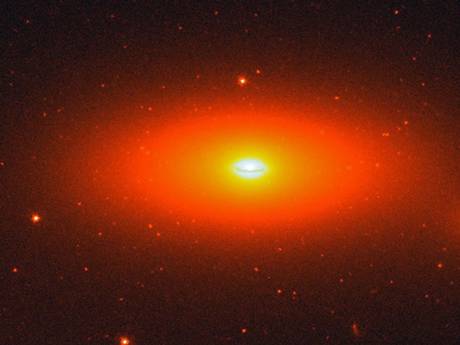Search
Democracy Links
Member's Off-site Blogs
oddball ....

A supermassive black hole, 4,000 times larger than the one at the centre of the Milky Way, has been spotted by astronomers.
The black hole, which has a mass some 17 billion times that of our Sun, is all the more surprising as it has been found residing in a tiny galaxy.
It therefore defies the traditional model of black hole growth that dictates they evolve in tandem with their host galaxies.
It lies at the heart of a small lens-shaped galaxy called NGC1277, which is 220 million light years away in the constellation Perseus.
The black hole makes up an enormous 14 per cent of the galaxy's mass. Other black holes found at the centres of galaxies account for only about 0.1 per cent.
Dr Karl Gebhardt, the lead scientist from the University of Texas at Austin, said: "This is a really oddball galaxy. It's almost all black hole."
Scientists have been searching for the Universe's largest black hole using the Hobby-Eberly Telescope, which is based in Texas.
They undertook a survey of nearly 900 host galaxies.
Black holes are formed from matter collapsing to the point where normal laws of physics break down.
They are massively dense objects, which have gravity that's strong enough to trap light.
Supermassive black holes, like the one discovered by scientists on this occasion, are thought to be at the centre of most large galaxies.
Contrary to expectations the research team discovered that some of the largest black holes they found were located in some of the smallest galaxies.
The black hole in this instance is more than 11 times wider than the orbit of Neptune, the eighth planet in the Solar System.
A description of the black hole, found by astronomers using the nine-metre Hobby-Eberly Telescope in Texas, appears in the journal Nature.
The discovery could change theories of how black holes and galaxies form and evolve, say the scientists.
- By John Richardson at 30 Nov 2012 - 10:03pm
- John Richardson's blog
- Login or register to post comments
Recent comments
3 hours 1 min ago
3 hours 5 min ago
5 hours 47 min ago
5 hours 50 min ago
7 hours 35 min ago
7 hours 48 min ago
7 hours 55 min ago
17 hours 58 min ago
18 hours 25 min ago
18 hours 39 min ago